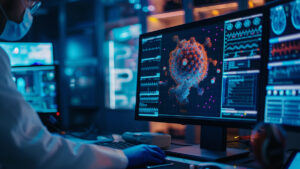Artificial intelligence (AI) is transforming business models worldwide, but one of its most promising applications is in the operating room. AI-assisted robotic surgery is the result of a combination of advanced robotics, sophisticated machine learning algorithms, and precision medicine. This technology promises to transform surgical procedures, shorten patient recovery times, and potentially make complex surgeries more accessible to patients in remote areas.
This type of surgery isn’t science fiction; thanks to extensive research, clinical studies, and practical applications, it’s becoming a reality. We are on the cusp of a medical revolution, as the global surgical robotics market is expected to grow rapidly. As AI continues to develop, its role in improving surgical techniques, reducing human error, and enabling personalized treatments will also change. In the future, surgery will be safer, faster, and more effective than ever.
The Current Role of AI in Robotic Surgery:
The da Vinci Surgical System and other AI-assisted robotic devices already provide surgeons with high-definition 3D vision, reduced vibration, and highly precise movements. These systems do not replace surgeons; they simply expand their capabilities. AI systems can now review preoperative images, predict potential problems, and support surgeons in performing challenging surgeries. While most systems require direct human guidance, AI enables surgical procedures to be performed semi-autonomously or even fully autonomously in a controlled environment. Using this technology, hospitals report shorter surgeries, smaller incisions, and faster recovery times. This is positive news for both patients and medical staff.
Technologies Driving the Impact of AI-Driven Surgical Systems:
AI-assisted robotic surgery utilizes various technologies working together. Machine learning algorithms analyze vast amounts of surgical records, patient outcomes, and medical images, and are constantly improving. Using computer vision, robotic arms can pinpoint anatomical features with high precision, reducing the risk of damaging nearby tissue. Voice control of surgical instruments will soon be possible thanks to natural language processing. Cloud computing facilitates instantaneous updates and enhances performance. In the future, 5G connectivity may even enable surgeons to provide remote assistance, even across borders. The convergence of these technologies is creating entirely new medical fields that transcend current practice.
Future Potential and Impact on Healthcare:
The possibilities of AI-assisted robotic surgery extend far beyond hospital operating rooms. Telesurgery, where expert surgeons operate robotic devices from hundreds or even thousands of miles away, could help people in rural and underserved areas. Doctors can use predictive analytics to select the best surgical approach for each patient, reducing risks and increasing success rates. Because AI models are constantly improving, each operation feeds data into the system, making future surgeries even more accurate. In the long run, this device could contribute to lower healthcare costs by reducing the risk of postoperative complications and shortening hospital stays.
Ethical and Legal Issues:
AI-assisted robotic surgery has enormous potential, but it also raises serious ethical and legal issues. Patient safety must always be paramount and requires careful testing before widespread use. Regulators such as the FDA are working to establish clear regulations for medical devices that use AI. These regulations will ensure the safety and effectiveness of these devices. Because surgical AI systems require extensive patient data to learn and improve, data privacy issues are also a concern. To ensure mutual trust between patients and healthcare providers, decision-making algorithms must be clear and transparent. Furthermore, ensuring equal access to this technology is crucial to eliminating healthcare inequalities.
Conclusion:
AI-assisted robotic surgery has the potential to transform how surgery is performed, taught, and made accessible. It’s more than simply replacing outdated instruments with robots; it empowers people to perform their jobs better through intelligent, data-driven precision. As AI advances, surgery can become faster, safer, and more tailored to each patient’s needs. The combination of robotics and AI could help break down geographic barriers to high-quality care and usher in a new era of global medical collaboration. Despite the need to address some ethical and legal issues, the momentum is strong. We are entering a new era in which the operating room is not only a place for healing but also a hub for technological innovation that pushes the boundaries of medicine.
FAQs:
1. What is AI-assisted robotic surgery?
AI-assisted robotic surgery combines advanced robotics and AI to help surgeons perform their work with greater precision, flexibility, and control than traditional methods.
2. Can AI-assisted surgical robots operate independently?
Currently, surgeons use AI to control most systems. However, research is exploring the possibilities for semi-autonomy and full autonomy under controlled conditions.
3. How can AI improve surgery?
Artificial intelligence can assess patient data, control surgical equipment, and identify problems in real time. This means fewer problems and faster recovery times.
4. What are the risks of using AI in surgery?
There are many potential risks, such as technical malfunctions, cyberattacks, and the use of insufficiently tested algorithms. This is why strict regulations are essential.
5. When will AI-assisted robotic surgery become widespread worldwide?
Experts expect AI to become more widely used in the coming decade, particularly in advanced healthcare systems. The widespread adoption of AI depends on the technology’s cost, government approval, and infrastructure.




